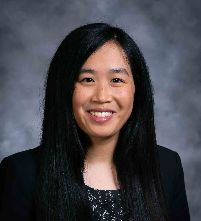MSACL 2024 Abstract
Self-Classified Topic Area(s): Proteomics > Cases of Unmet Clinical Needs
|
|
Poster Presentation
Poster #23b
Attended on Wednesday at 14:30
|

|
 Detection of Patient Monoclonal Serum Free Light Chains by On-Probe Extraction coupled with High-Resolution Mass Spectrometry Detection of Patient Monoclonal Serum Free Light Chains by On-Probe Extraction coupled with High-Resolution Mass Spectrometry
Priscilla S.-W. Yeung (1, 2), Yajing Liu (1), Ashley Ruan (1), Christina Kerr (1), Run-Zhang Shi (1, 2), David J. Iberri (3), Ruben Y. Luo (1, 2)
(1) Department of Pathology, Stanford University, Stanford, CA, USA (2) Clinical Laboratories, Stanford Health Care, Palo Alto, CA, USA (3) Department of Medicine, Division of Hematology, Stanford University, Stanford, CA, USA

|
Priscilla Yeung, MD, PhD (Presenter) 
Stanford University Department of Pathology >> POSTER (PDF) |
|
Presenter Bio: Priscilla Yeung is a Clinical Pathology Resident at Stanford University interested in using mass spectrometry to discover improved biomarkers for clinical testing. Her current research with Dr. Ruben Luo is focused on applying top-down mass spectrometry to the diagnosis of monoclonal gammopathies. Prior to residency, she completed her MD/PhD training at Northwestern University, where she studied the biophysical mechanisms of calcium channel gating with Dr. Murali Prakriya, and her undergraduate studies at University of Pennsylvania, where she studied amyloid-beta protein misfolding with Dr. Paul Axelsen. |
|
|
|
|
Abstract INTRODUCTION: Multiple myeloma is the second most common hematolymphoid malignancy in the United States and has a median survival of 6 years after diagnosis. It is part of a larger group of plasma cell neoplasms that range from monoclonal gammopathy of uncertain significance (MGUS), to smoldering myeloma (SM), to fulminant multiple myeloma (MM), and include extramedullary manifestations such as plasmacytomas or amyloidosis. One of the essential clinical markers of plasma cell neoplasms is serum free light chains (FLC), which are circulating antibody light chains that are unbound to heavy chain. The current widely used immunoassay method quantifies total serum FLCs, including the polyclonal background. Although a skewed kappa/lambda (K/L) FLC ratio is often used as a proxy for clonality, some patients, such as those with renal disease, can have ambiguous results that can benefit from a direct measurement of clonality.
OBJECTIVES: The purpose of this study was to develop an assay that couples an on-probe extraction immunocapture step with high-resolution mass spectrometry (OPEX-MS) to determine the clonality of serum free light chains.
METHODS: Remnant patient samples with FLC immunoassay results from the Stanford Clinical Chemistry Laboratory were collected and processed according to Institutional Review Board protocols approved by Stanford Health Care. Immunocapture with on-probe extraction was performed using streptavidin probes and biotinylated capture antibodies (anti-kappa light chain and anti-lambda light chain) on a Gator Plus analyzer. Captured proteins were eluted using 0.3% formic acid to break the antibody-antigen association and rinsed with phosphate buffered solution with Tween. The analyte capture and elution steps were repeated 30 times for optimal signal to noise ratio. Liquid chromatography-mass spectrometry was performed on a TLX-2 multi-channel HPLC coupled with a Q-Exactive Plus mass spectrometer. Proteins were separated on a reverse phase HPLC column (MAbPac, 2.1 mm X 5 mm). Mobile phase A was 0.1% formic acid in water and mobile phase B was 0.1% formic acid in acetonitrile. Data analysis was performed on BioPharma Finder 5.1 software using a sliding window ReSpect deconvolution algorithm.
RESULTS: Four cohorts of samples from unique patients were tested based on Binding Site Optilite FLC results: Negative (n = 50), Kappa Positive (n = 49), Lambda Positive (n = 46), and Dual Elevated (n = 100). In the Negative, Kappa Positive, and Lambda Positive cohorts, OPEX-MS showed good overall concordance (91%) with the immunoassay method. In samples with conflict results, majority of the samples in the Kappa Positive cohort that were negative by OPEX-MS had K/L FLC ratios that were only slightly elevated. OPEX-MS identified clonal FLCs in a subset of the Dual Elevated cohort with a normal K/L ratio.
CONCLUSIONS: The OPEX-MS method can serve as a complementary approach to determine clonality in patients with difficult-to-interpret FLC immunoassay results. |
|
Financial Disclosure
| Description | Y/N | Source |
| Grants | no | |
| Salary | no | |
| Board Member | no | |
| Stock | no | |
| Expenses | no | |
| IP Royalty | no | |
| Planning to mention or discuss specific products or technology of the company(ies) listed above: |
no |
|

